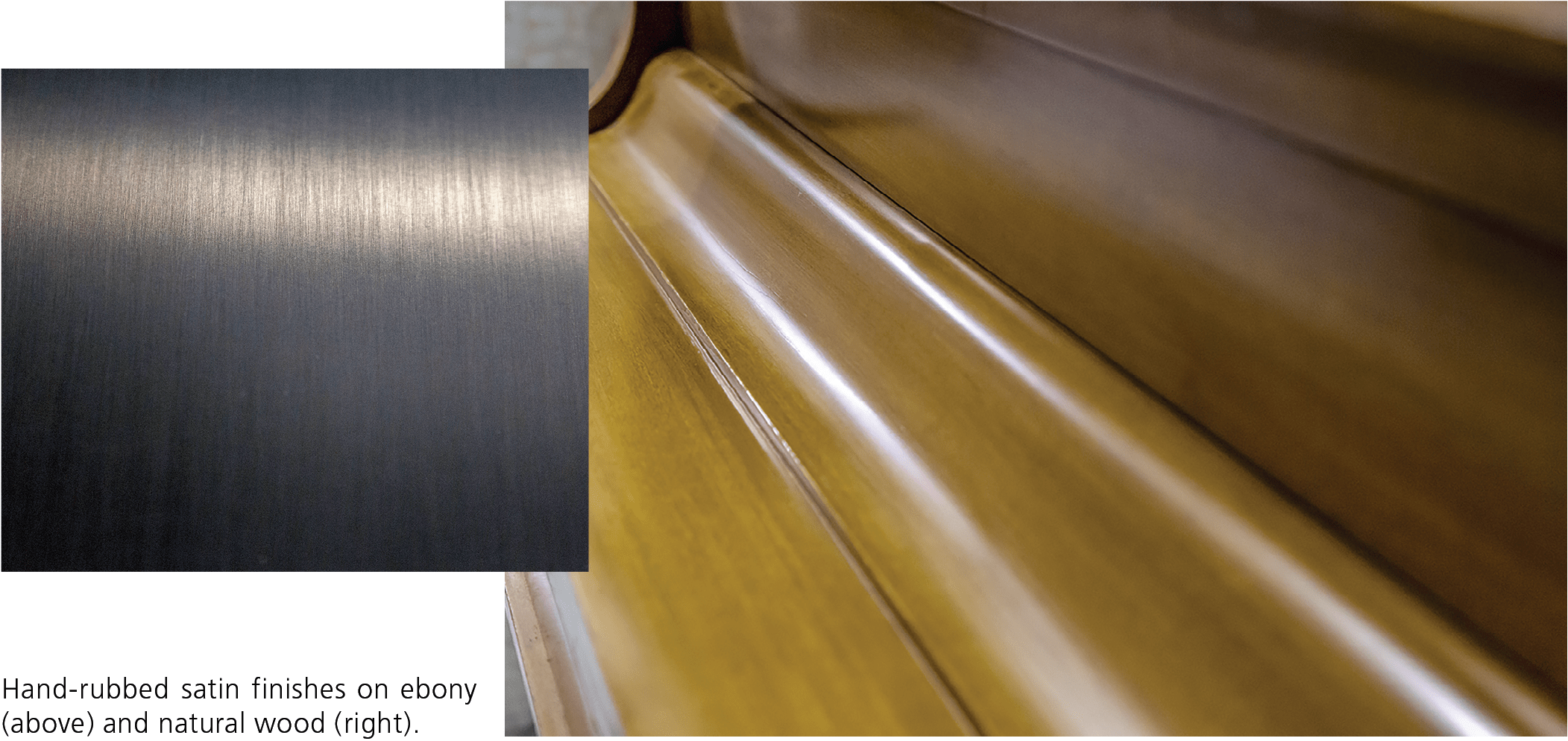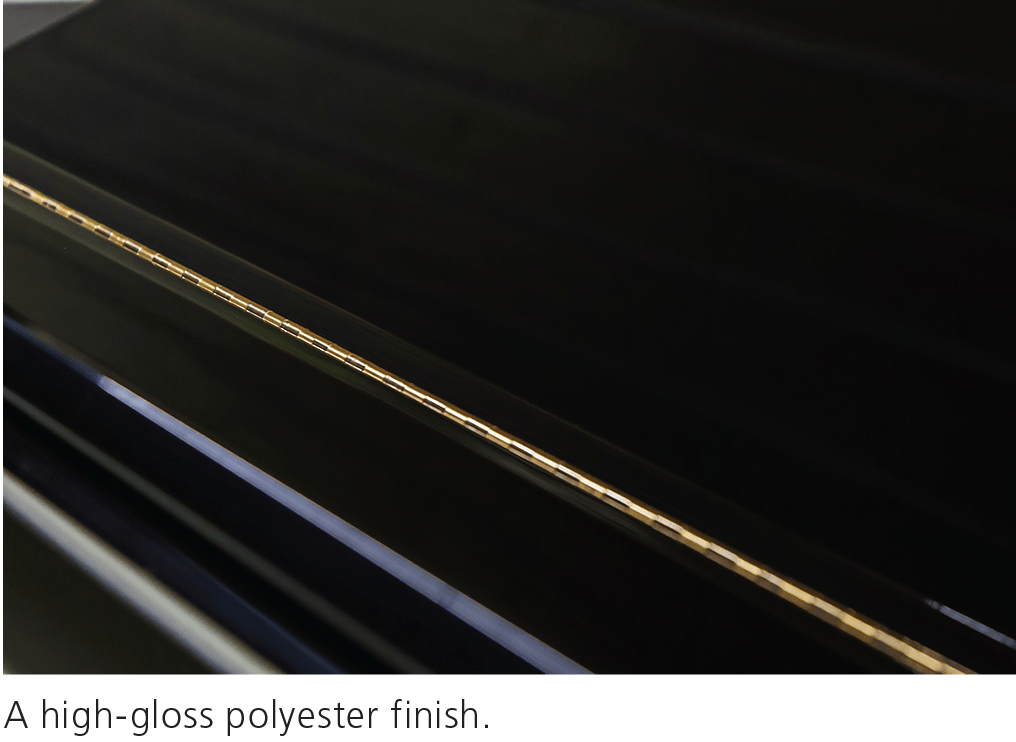Satin Finishes

A satin finish reflects light but not images. Satin finishes may be of any color, including ebony (black), or wood tones such as cherry, mahogany, and walnut. Regardless of whether the finishing material is lacquer, polyester, or something else, the process of applying the finish is similar.
First, numerous layers of high-gloss material are applied; typically, each layer is lightly sanded before the next layer is applied. When an adequate thickness of material has been built up, the finish is left to cure for a while, then rubbed to a satin finish. The rubbing is done with #0000 steel wool or, in some instances, 600-grit wet/dry sandpaper or other abrasive. A rubbing lubricant, along with water on the abrasive applicator, serves as a buffer. The rubbing is done in one direction only, to create tiny grooves in the finish that diffract light (see photo). In this way, the original high-gloss sheen is knocked down to a hand-rubbed satin sheen that is dull but elegant.
Caring for this type of finish can be problematic, for two reasons. First, body oils from fingerprints can get trapped in the tiny finish grooves, and are not easily removed by a simple dusting. Second, if the finish is wiped in a circular motion, the fine grooves become uneven, disturbing the original even pattern of light reflection and thus ruining the satin effect. Over time, repeated polishing in the wrong direction can actually remove the tiny grooves and bring the finish down to the base of the high-gloss material. An example of this condition would be an older satin finish that now looks somewhat “semigloss” due to overwiping and overpolishing.
The adage “less is more” is applicable to caring for a satin finish. In most cases it is unnecessary to apply polishes or cleaners to remove ordinary dust or dirt—a simple dusting with a non-abrasive cloth is sufficient. If you want to remove fingerprints, a mild cleaner can be applied. A product specifically designed for this purpose is our Cory Pre-Polish Finish Cleaner, but you can also use a microfiber cloth dampened with warm water and Ivory liquid dish detergent, then a separate, dry microfiber cloth to remove any remaining moisture. Apply the cleaning liquid directly to the cloth, and be sure to wipe in a back-and-forth motion only in the direction of the satin “grain.”
Another type of satin finish is created by adding a pigment to the high-gloss material, to suppress the high shine of the finish. This type of finish is often less expensive because it is usually not rubbed, but instead is left as is for a duller, matte appearance. Some dealers and rebuilding shops use this type of finish when refinishing a piano. The recommendation for care remains the same as for a rubbed finish, although the direction of wiping is not as critical.
Avoid using waxes, products with ammonia, oils, petroleum-based products, or grocery-store aerosols. These types of household cleaners will make the finish appear hazy, milky, or smeared.
High-Gloss Finishes
High-gloss finishes act as mirrors, reflecting both light and images, and the material most commonly used in today’s high-gloss finishes is polyester. Pioneered in the 1960s, polyester finish is a two-part synthetic resin that completely hardens during curing, is resistant to cracks, and can’t be broken down by solvents. Polyester finishes are the most durable of all piano finishes, but their hardness and resistance to solvents make them more difficult to repair when damaged.

Aside from damage repair, polyester finishes are easier to maintain than satin finishes, but still require proper care. Using ammonia, solvents, or waxes generally will not damage the finish, but will create a smeary, uneven appearance as these contaminants build up over time. In addition, some polyesters themselves may not be of high quality, and will eventually haze over. If oil- or solvent-based polishes were previously used on the piano, or if its surfaces are dirty, a simple cleaning with a mild solution is recommended to remove the contaminants and dirt before polishing. Use my suggestions in the Satin Finishes section, above, to do a thorough cleaning before applying a polish. Once again, I recommend that you use a clean, high-quality microfiber cloth (see below) when caring for a high-gloss finish, to avoid scratching or uneven results. More abrasive cloths can create surface scratches.
Some polishes are designed specifically for high-gloss finishes. Many piano manufacturers recommend our Cory Super High-Gloss Piano Polish, a water-based polish that contains no solvents, waxes, or harmful additives. This special, emulsified blend of polymers will not build up, smear, or leave other undesired results. It’s worth stressing that oil and water don’t mix—when using a water-based product such as ours after an oil-based product, it’s paramount to first clean the surface for best results.
Other types of high-gloss finishes include polyurethane and lacquer. Polyurethane is a bit softer than polyester, and lacquer is softer yet. Care must be taken when using cleaners or polishes with these finishes—avoid those based on solvents, petroleum-based paraffin wax, or ammonia. Note that, although more easily damaged than polyester, lacquer is often considered the most beautiful of high-gloss finishes, and is used on some of the most expensive pianos.
Open-Pore Finishes

Open-pore finishes are used primarily on pianos with natural wood-veneered cabinets (i.e., not ebony). Though not as commonly used on pianos as satin and high-gloss finishes, open-pore finishes are often used as an alternative to satin on instruments made in Europe, as well as on furniture such as end tables, coffee tables, and bed headboards. An open-pore finish is achieved using a sanding sealer and a coat or two of lacquer or polyurethane. However, it is not rubbed, nor is the grain completely filled, which gives an open-pore finish a sheen somewhere between satin and matte. The way to identify this type of finish is to examine it closely, to ascertain if the wood cells are exposed, and not filled (see photo).
There are many options for the care of open-pore finishes; I recommend conditioning and preserving with an oil- or petroleum-based product. Howard’s and Old English are two brands that are popular in the furniture world. Our company, Cory Products, makes specific blends for piano finishes, such as Honey Oak, Natural Wood, and our very popular Harmony Detailing Oil. But regardless of which conditioning polish you use, be sure to remove any excess—otherwise it will collect dust and create a buildup of grime.
Should the finish be worn, or with visible bare wood due to gouging or scrapes, you can use products such as Old English Scratch Cover or Cory Scratch-Brite Fine Wood Restorer. Note that using products containing paraffin waxes may leave the finish tacky to the touch.
In all cases, avoid spraying any product on or near the piano’s tuning pins or strings. The wisest choice is usually to first apply the product to the cloth, then the cloth to the wood.
Microfiber Cloths
Microfiber cloths are superior to other cloths for maintaining fine finishes, and are recommended for all finish care. However, not all microfiber cloths are created equal; the higher the quality, the better the cleaning results. Most microfiber cloths are made of 80% polyester and 20% polyamide, as polyester has an affinity for oil and polyamide has an affinity for water. You can judge the quality of a microfiber cloth in part by its weight, measured in grams per square meter (gsm). Good cloths start at around 200 gsm; the best are over 400 gsm. If the cloth is hemmed, make sure that the stitching contains no nylon, which will scratch the finish.